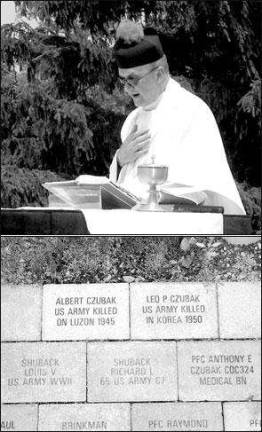Post script to Memorial Day in the Village of Florida

Florida - Time constraints and looming deadlines forced the omission of several poignant thoughts pertaining to Memorial Day in the Village of Florida. Col. John Seward, grandfather of Secretary of State William H. Seward and father of Samuel S. Seward, the founder of Seward Institute, was indeed a Revolutionary War hero. Actually he was a colonel in the New Jersey Militia. And it is a fact that he is interred in the Seward Vault at the Florida Cemetery, making him one of the earliest war veterans to be buried there. (That vault was excavated shortly before 1813.) Col. Seward was a close acquaintance of General Washington who frequently stopped at the colonel’s house just up the mountain on Route 515 above Vernon, N.J. The foundation of that house is all that exists today. Almost forgotten tales of Col. Seward also exist today. One frequently repeated is the time a Tory spy approached the house with a note, supposedly from a superior officer requesting the colonel’s presence at a meeting. The colonel suspected something wasn’t genuine in that request and upon being challenged, the rider frantically spurred his horse to retreat. The colonel quickly grabbed a rifle from his porch and felled the fleeing horseman. Both the colonel and his wife were originally buried in New Jersey, but the remains were later brought to the Seward Vault. Samuel and his wife, the former Mary Jennings, are also interred in that vault. On the plot above are also buried several other Sewards, including Dr. Frederick W. Seward, who owned the renowned Interpines Sanitarium in Goshen, situated approximately where the Orange County Government Center is located today. The most prominent Seward, William Henry Seward, who in a sense was a “veteran” of the Civil War, is buried in Auburn, N.Y., his home for most of his adult life. According to Florida Cemetery Superintendent Raymond Green, one section of that cemetery is the burial place of approximately 50 Civil War veterans. Most notable is the monument marking the grave of Capt. William E. Mapes, an officer in the famed 124th N.Y.S. Volunteers, better known locally as the “Orange Blossoms.” About 135 small American flags were set out prior to Memorial Day marking the graves of the veterans. According to a cemetery pamphlet written in 1993, there are three veterans of the Revolutionary War, six who served in the War of 1812, five from the Spanish-American War, 27 from World War One, 19 from World War Two, and one each from the Korean and Vietnam conflicts. The noon Mass offered by the Rev. Joseph Tokarczyk at St. Joseph’s Cemetery also conjures up stories of departed veterans. Approximately 200 flags were set in place at that cemetery marking the veterans buried there. Several gravestones mark those who were killed in action. One in particular is heart-rending: The names of brothers Albert and Leon Czubak are both engraved on one stone. Albert was killed in action during WW II and Leon was killed in action during the Korean War. With the ranks of the WW II veterans decreasing every year., it will be up to the younger veterans to keep alive the memories of those who have gone before. The flame must also be carried by those too young to serve, as S.S. Seward junior Amanda Gallagher did in her essay, “What America Means to Me,” which she read at the services. Dressed in patriotic red, white and blue, her voice rang loud and clear among the silent spectators scattered alongside the cold-to-the-touch gravestones of past generations. Earlier, Zophia Groppi, a fourth-grader at Golden Hill Elementary, was almost as eloquent as she read her essay, “What the American Flag Means to Me.” And Girl Scout Jenice Perez, escorted by Eagle Scouts Billy and David Kelemen, gently placed a memorial wreath at the War Veterans Monument. A final rifle salute and “Taps” ended the service. The solemnity of the occasion was lifted a little by American Legion Commander James L. Sosler in his closing remarks with his observation that “Hot dogs taste better on Memorial Day, hamburgers taste better on Memorial Day, and baseball is more exciting on Memorial Day.” There was no baseball across the road as in the 60’s, 70’s, and 80’s which drew as many as 400-500 for the Memorial Day game, but there were hot dogs and other refreshments served up by the members of the Florida Fire Department and Rescue Squad. That was Memorial Day 2006 in the Village of Florida: A small but wholesome slice of Americana.